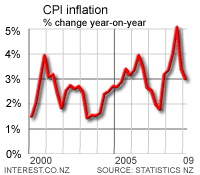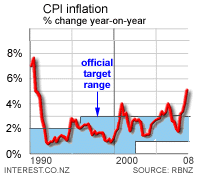 Annual consumer price inflation hit an 18 year high of 5.1% in the September quarter, but this was in line with market expectations and a backward looking indicator that is unlikely to stop the Reserve Bank from cutting the Official Cash Rate by 100 basis points to 6.5% on Thursday.
Statistics New Zealand reported that the CPI rose 1.5% in the September quarter from the June quarter, pushing the annual inflation rate to 5.1%, its highest level since June 1990, which was shortly after an increase in the rate of the Goods and Services Tax.
It is well above the Reserve Bank's target band of 1-3% on average over the medium term.
Annual consumer price inflation hit an 18 year high of 5.1% in the September quarter, but this was in line with market expectations and a backward looking indicator that is unlikely to stop the Reserve Bank from cutting the Official Cash Rate by 100 basis points to 6.5% on Thursday.
Statistics New Zealand reported that the CPI rose 1.5% in the September quarter from the June quarter, pushing the annual inflation rate to 5.1%, its highest level since June 1990, which was shortly after an increase in the rate of the Goods and Services Tax.
It is well above the Reserve Bank's target band of 1-3% on average over the medium term.
 Non tradeables inflation, which is inflation not linked to international prices such as petrol and food and most able to be controlled by the Reserve Bank, hit a record high of 1.3% for the quarter and remains at 4.1% on an annual basis. It has consistently been above 3% since 2003.
Big contributors to the increase were higher food prices, higher petrol prices and higher local body rates, but economists are pointing to sharp falls in petrol prices and slowing global growth since the end of the September quarter that are likely to keep inflation in check.
Here's the key details below from Statistics NZ.
Non tradeables inflation, which is inflation not linked to international prices such as petrol and food and most able to be controlled by the Reserve Bank, hit a record high of 1.3% for the quarter and remains at 4.1% on an annual basis. It has consistently been above 3% since 2003.
Big contributors to the increase were higher food prices, higher petrol prices and higher local body rates, but economists are pointing to sharp falls in petrol prices and slowing global growth since the end of the September quarter that are likely to keep inflation in check.
Here's the key details below from Statistics NZ.
Meanwhile, food prices rose 0.6% in September from August and were up 10.8% for the year, the highest food price inflation since April 1990. Here are the key details from Statistics NZ on food prices. Pork and broccoli prices were particular culprits in September.Nine of the 11 CPI groups recorded increases in the September 2008 quarter. The most significant upward contributions came from the food (up 3.7 percent), housing and household utilities (up 1.4 percent) and transport (up 2.0 percent) groups. Other upward contributions came from the following groups: alcoholic beverages and tobacco (up 1.3 percent), recreation and culture (up 0.8 percent), health (up 1.4 percent), household contents and services (up 0.8 percent), miscellaneous goods and services (up 0.5 percent), and education (up 0.1 percent).
Two groups recorded decreases: communication (down 1.1 percent), and clothing and footwear (down 0.4 percent). The most significant individual upward contributions came from higher prices for petrol (up 4.6 percent), lettuce (up 94.9 percent), overseas package holidays (up 13.2 percent), and local authority rates and payments (up 4.7 percent). The most significant individual downward contributions came from lower prices for second-hand motor cars (down 8.0 percent).
Food prices rose 0.6 percent in September 2008, following increases of 2.7 percent and 0.6 percent in August and July 2008, respectively.In September 2008, higher prices were recorded for the following subgroups: meat, poultry and fish (up 3.7 percent), grocery food (up 0.5 percent), restaurant meals and ready-to-eat food (up 0.4 percent), and non-alcoholic beverages (up 0.3 percent). Lower prices were recorded for the fruit and vegetable subgroup (down 2.2 percent). The most significant individual upward contributions came from higher prices for beef (up 6.8 percent), tomatoes (up 16.3 percent), yoghurt (up 11.6 percent), fresh chicken (up 5.8 percent), pork (up 11.9 percent), and broccoli (up 19.8 percent). The most significant individual downward contributions came from lower prices for lettuce (down 20.6 percent), and cucumber (down 43.8 percent).

We welcome your comments below. If you are not already registered, please register to comment.
Remember we welcome robust, respectful and insightful debate. We don't welcome abusive or defamatory comments and will de-register those repeatedly making such comments. Our current comment policy is here.